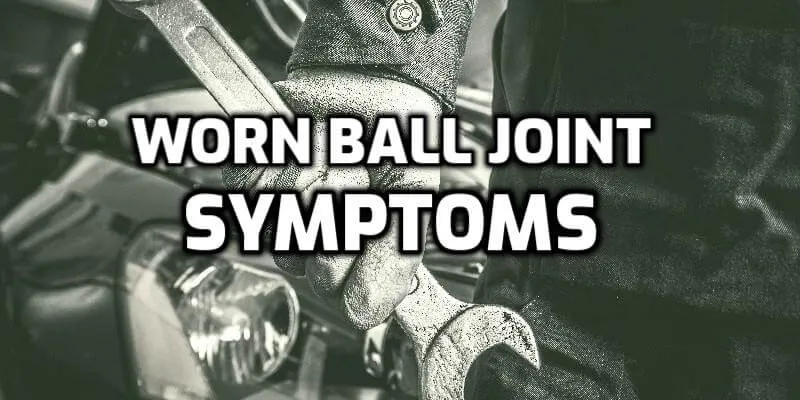4 Worn Ball Joint Symptoms

Ball joints are spherical bearings used on automobiles to connect the control arms to the steering knuckles. A ball joint and its different parts are made of steel and it usually consists of a bearing stud and socket enclosed in a casing. The bearing stud is mainly tapered and threaded to fit into the tapered hole in the steering knuckle. The steel casing of this ball joint system protects from dirt and gets hampered.
But ball joints are likely to be malfunctioned after being used for a long time in an automobile. Sometimes you may not even realize that a ball joint of your car is not functioning well. But there are certain ways to tell that the ball joint has gone bad.
Squeaking And Clunking Noises:
If a car’s ball joint has been damaged or not working properly, it declares its malfunctioning situation by making squeaking and clunking noises. That means if you may listen to unusual sounds while driving. These unusual squeaking and clunking noises indicate the damaging situation of ball joints.
The reason for these noises is the ball joints are seizing up. If the protective rubber boot gets torn or damaged sand and grime can get into the joint, causing it to seize up. The joint may no longer be in the right condition and as a result, it is making squeaking and clunking noises.
Vibrating and Shaking:
Disjoining of ball joints creates vibration while driving also. You will not feel comfortable driving your car because it will vibrate and shake for the loose ball joints. This shaking and vibrating condition of your car or vehicle can make your journey uncomfortable and troublesome. So if you are facing this kind of problem on your drive, you should check your ball joints first to see if those are in their right condition.
Loose or Shaky Steering
The steering function is designed so that if we release the steering from a full left or right position while driving, it will automatically turn and take a neutral straightforward position. This happens because of the existing ball joint between the control arms and the steering knuckles.
If there is a malfunctioned and worn-out ball joint in the system, the steering will not work this way properly. As a result, the steering may wander from side to side, making it dangerous because it can cause an accident. Also, for this reason, you may have to put a lot of effort and find it difficult to keep the car going in the right straight direction.
Uneven Tire Wear:
Torn-down or bad ball joints may hamper the alignment of your car. The misaligned condition of a car puts so much pressure on the tires of any specific side. As a result, the tires will get worn down quickly. So if you do not change the ball joints, you may need to change the tires frequently for that.
You can also easily identify bad ball joints by their extreme condition.
- The surface of the ball joint gets cracked for dirt, oil, water to be in use for a long time.
- There should be no upper or lower movement in a ball joint and if there is, you need to conclude that the ball joint is faulty and bad.
- The bad ball joint would be smooth, loose, and clunky as the good ball joints are tight and smooth.
- The bad ball joint would barely be held into one place.
These are the ways to identify a bad ball joint. If you are facing any of these symptoms or conditions, it is time for you to replace the ball joint.
How Long Do Ball Joints Last?
Ball joints are essential parts of an automobile’s suspension. What kind of ball joint you should use depends on your car’s making, model, and suspension type. All joints always keep working any time you are driving, and they are not permanent fixtures in your vehicle. The ball joints are vulnerable to rough road conditions, as well as ordinary wear and tear.
Generally, the ball joints get ready to be replaced between 70,000 to 150,000 miles of driving. Excessive play in the joint can cause additional wear, and if a ball joint fails, your car’s suspension could collapse and you could lose control of the vehicle.
Suppose your vehicle frequently bears tons of weight and tow. In that case, it is likely to wear down the vehicle’s ball joints prematurely because high weighted loads put so much pressure on your vehicle’s suspension, which also pressurizes the ball joints and results in premature failure of the ball joints.
Frequently Asked Questions (FAQ)
What happens when ball joints go bad?
The ball joint is a key component of your vehicle’s suspension, and it allows the wheel to move up and down while keeping the tire in contact with the ground. Ball joints typically last for the life of the vehicle, but they can sometimes wear out prematurely. If your ball joints are starting to wear out, you may notice some symptoms, including:
* A clicking noise when turning the steering wheel
* A rough ride
* Uneven tire wear
If you’re experiencing any of these symptoms, it’s important to have your vehicle inspected by a qualified mechanic as soon as possible. Ball joint failure can lead to serious safety issues, so it’s important to get them fixed before they cause any problems.
Relate Article
